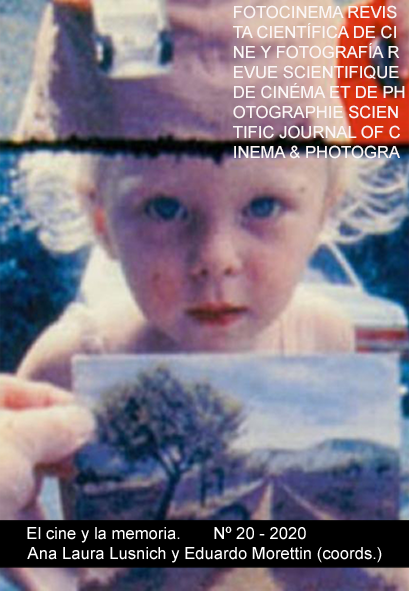Secret and generational transmission. The documentary film before the family memory
DOI:
https://doi.org/10.24310/Fotocinema.2020.v0i20.7602Keywords:
Memory transmission, Crypt, Generations, Documentary Cinema, Genocide, Dictatorship.Abstract
The bonds that link each person with the preceded generations influence him in a complex way. Psychoanalysts Nicolás Abraham and Maria Torok suggests that what has not been elaborated can form a crypt, an element impregnated by secrets or unrealized duels. For these authors, the secret (s) found in the crypt can be transmitted to the next generation. This theoretical perspective has been of interest to think about the effects of the experience of going through and surviving a genocide as well as that of torture and confinement under dictatorships.
It will be from this axis that this paper intends to analyze the problem of secrecy and the generational transmission of experiences of genocides and dictatorships in documentary cinema. For this purpose, the following titles will be taken: New Year Baby (Socheata Poeuv, 2006), The Flat (Arnon Goldfinger, 2011), and El color del camaleón (Andrés Lübbert, 2017). Although each one presents different historical cases and experiences, the three titles have certain characteristics that relate them, becoming suggestive tools to investigate not only in the transmission of trauma between generations but also in the dynamics of family memory.
Downloads
Metrics
Publication Facts
Reviewer profiles N/A
Author statements
Indexed in
-
—
- Academic society
- N/A
- Publisher
- Universidad de Málaga
References
Abraham, N. & Torok, M. (2005). La corteza y el núcleo. Buenos Aires: Amorrortu.
Bossay, C. (2017). El color del camaleón. Si niegas tu pasado, tu presente es falso. laFuga. Recuperado de http://2016.lafuga.cl/el-color-del-camaleon/857
Cohen, S. (2005). Estados de negación. Ensayo sobre atrocidades y sufrimiento. Buenos Aires: Facultad de Derecho UBA.
Danieli, Y. (1998). Introduction: History and Conceptual Foundations. En Y. Danieli (Ed.), International Handbook of Multigenerational Legacies of Trauma. Nueva York: Springer.
De Langis, T., Strasser, J., Kim, T. & Taing, S. (2014). Like ghost changes body. A Study on the Impact of Forced Marriage under the Jemeres Rojos Regime. Phnom Penh: Transcultural Psychosocial Organization.
Feierstein, D. (2012). Memorias y representaciones. Sobre la elaboración del genocidio. Buenos Aires: Fondo de Cultura Económica.
Freud, S. (1991). Obras completas. Vol. XVI Conferencias de introducción al psicoanálisis, parte III. Buenos Aires: Amorrortu.
Kancyper, L. (2011, enero 8). El heredero y el héroe. Página/12. Recuperado de https://www.pagina12.com.ar/diario/psicologia/subnotas/159921-51289-2011-01-08.html
Prager, B. (2015). After the Fact. The Holocaust in Twenty-First Century Documentary Film. New York: Bloomsbury Academic.
Renov, M. (2004). The Subject of Documentary. Minneapolis: University of Minnesota Press.
Tisseron, S. (1997). Introducción. El psicoanálisis ante la prueba de las generaciones. En S. Tisseron (Ed.), El psiquismo ante la prueba de las generaciones. Clínica del fantasma. Buenos Aires: Amorrortu.
Watson, P. (1982). Guerra, persona y destrucción. México: Nueva Imagen.
Welzer, H., Moller, S. & Tschuggnall, K. (2012). Mi abuelo no era nazi. El nacionalsocialismo en la memoria familiar. Buenos Aires: Prometeo.
Zoja, L. (2018). El gesto de Héctor. Barcelona: Taurus.
Zylberman, L. (2018). Cine documental y genocidio. Algunos problemas éticos. Journal de Ética y Cine, 8(3), 33-41.
Downloads
Published
How to Cite
Issue
Section
License
All contents published in Fotocinema Revista científica de cine y fotografía are protected under the Creative Commons Attribution-NonCommercial-ShareAlike 4.0 International (CC BY-NC-SA 4.0) license. All about this license is available in the following link: <http://creativecommons.org/licenses/by-nc-sa/4.0>
Users can copy, use, redistribute, share and exhibit publicly as long as:
- The original source and authorship of the material are cited (Journal, Publisher and URL of the work).
- It is not used for comercial purposes.
- The existence of the license and its especifications are mentioned.
There are two sets of authors’ rights: moral and property rights. Moral rights are perpetual prerogatives, unrenounceable, not-transferable, unalienable, imprescriptible and inembargable. According to authors’ rights legislation, Fotocinema. Revista científica de cine y fotografía recognizes and respects authors moral rights, as well as the ownership of property rights, which will be transferred to University of Malaga in open access. The property rights are referred to the benefits that are gained by the use or the dissemination of works. Fotocinema. Revista científica de cine y fotografía is published in an open access form and it is exclusively licenced by any means for doing or authorising distribution, dissemination, reproduction, , adaptation, translation or arrangement of works.
Authors are responsable for obtaining the necessary permission to use copyrighted images.














13.png)



